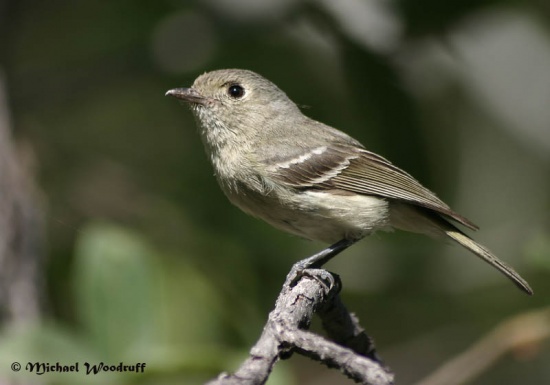(→External Links: Additional GSearch for common name. GSearch Checked template) |
|||
| (7 intermediate revisions by 4 users not shown) | |||
| Line 1: | Line 1: | ||
| − | + | [[Image:Hutton's_VireoMichaelW.jpg|thumb|550px|right|Photo by {{user|Michael+W|Michael W}} <br/>Location: [[Madera Canyon]], [[Arizona]], [[USA]]. ]] | |
| − | + | ;[[:Category:Vireo|Vireo]] huttoni | |
| − | [[Image: | ||
==Identification== | ==Identification== | ||
4 in. Olive-grey upperparts and yellow underparts. Eye ring is white and broken above eye. Undertail coverts are white. Wings are dark with two white bars. Sexes are similar. | 4 in. Olive-grey upperparts and yellow underparts. Eye ring is white and broken above eye. Undertail coverts are white. Wings are dark with two white bars. Sexes are similar. | ||
| + | |||
| + | ====Similar Species==== | ||
| + | Often mistaken for the [[Ruby-crowned Kinglet]], but note the black feet and slightly larger size of the vireo. | ||
| + | |||
==Distribution== | ==Distribution== | ||
| − | [[ | + | * '''Pacific Group:''' Southwest [[British Columbia]], [[California]], [[Baja California]]<br> |
| + | * '''Interior Group:''' [[Arizona]], [[New Mexico]], [[Texas]], mainland [[Mexico]], and [[Guatemala]] | ||
| + | |||
==Taxonomy== | ==Taxonomy== | ||
| + | There are two recognized groups of subspecies: the Pacific group has 8 subspecies and the Interior group has 5 subspecies.<sup>[[#References|[1]]]</sup> Recent DNA evidence may lead to a split of these groups into separate species.<sup>[[#References|[2]]]</sup>. | ||
| + | |||
==Habitat== | ==Habitat== | ||
Deciduous and mixed forests, primarily oak woodlands. | Deciduous and mixed forests, primarily oak woodlands. | ||
| + | |||
==Behaviour== | ==Behaviour== | ||
| + | * '''Diet:''' Gleaner of insects. | ||
| + | * '''Breeding''': Builds a hanging cup nest suspended from a fork of a tree. The female lays 3-4 eggs. The eggs are mostly white in color, with scattered brown spotting. | ||
| + | * '''Migration:''' Some short-distance and altitudinal migration, but mostly resident. They may join with other species in flocks in winter. | ||
| + | |||
| + | ==References== | ||
| + | #Clements, JF. 2008. The Clements Checklist of Birds of the World. 6th ed., with updates to December 2008. Ithaca: Cornell Univ. Press. ISBN 978-0801445019. Spreadsheet available at http://www.birds.cornell.edu/clementschecklist. | ||
| + | #Wikipedia | ||
| + | {{Ref}} | ||
==External Links== | ==External Links== | ||
| − | + | Search the Gallery using the scientific name: | |
| − | [[Category:Birds]] | + | {{GSearch|Vireo+huttoni}} |
| + | Search the Gallery using the common name: | ||
| + | {{GSearch|Hutton's Vireo}} | ||
| + | {{GS-checked}} | ||
| + | <br /> | ||
| + | <br /> | ||
| + | |||
| + | [[Category:Birds]] [[Category:Vireo]] | ||
Latest revision as of 18:32, 21 July 2022
- Vireo huttoni
Identification
4 in. Olive-grey upperparts and yellow underparts. Eye ring is white and broken above eye. Undertail coverts are white. Wings are dark with two white bars. Sexes are similar.
Similar Species
Often mistaken for the Ruby-crowned Kinglet, but note the black feet and slightly larger size of the vireo.
Distribution
- Pacific Group: Southwest British Columbia, California, Baja California
- Interior Group: Arizona, New Mexico, Texas, mainland Mexico, and Guatemala
Taxonomy
There are two recognized groups of subspecies: the Pacific group has 8 subspecies and the Interior group has 5 subspecies.[1] Recent DNA evidence may lead to a split of these groups into separate species.[2].
Habitat
Deciduous and mixed forests, primarily oak woodlands.
Behaviour
- Diet: Gleaner of insects.
- Breeding: Builds a hanging cup nest suspended from a fork of a tree. The female lays 3-4 eggs. The eggs are mostly white in color, with scattered brown spotting.
- Migration: Some short-distance and altitudinal migration, but mostly resident. They may join with other species in flocks in winter.
References
- Clements, JF. 2008. The Clements Checklist of Birds of the World. 6th ed., with updates to December 2008. Ithaca: Cornell Univ. Press. ISBN 978-0801445019. Spreadsheet available at http://www.birds.cornell.edu/clementschecklist.
- Wikipedia
Recommended Citation
- BirdForum Opus contributors. (2024) Hutton's Vireo. In: BirdForum, the forum for wild birds and birding. Retrieved 26 April 2024 from https://www.birdforum.net/opus/Hutton%27s_Vireo
External Links
Search the Gallery using the scientific name:
Search the Gallery using the common name:
GSearch checked for 2020 platform.




